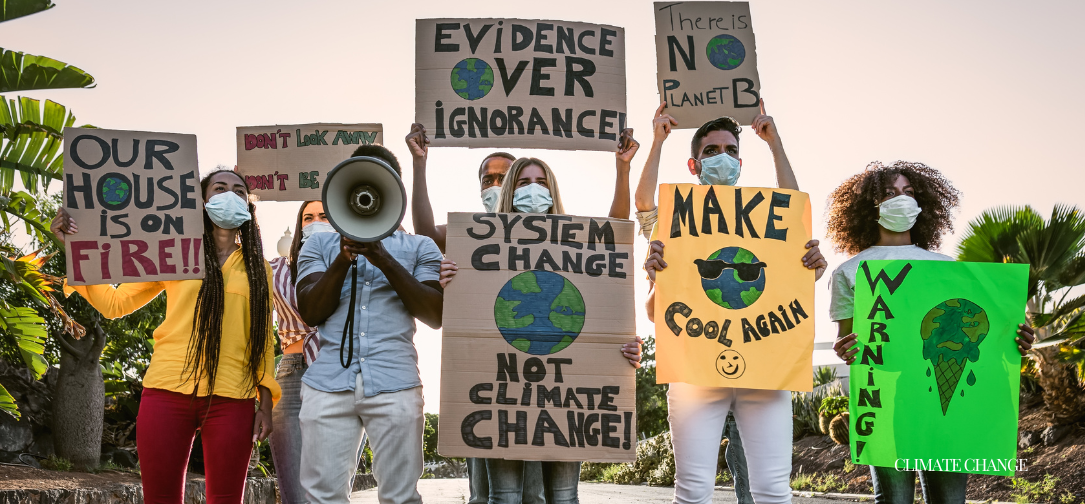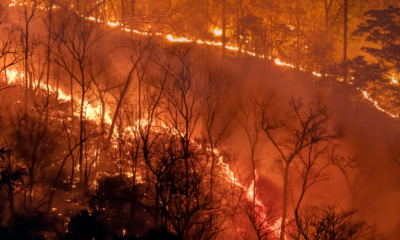Innovations
The Science Behind Climate Change: Understanding the Forces Driving Global Warming and Its Impact on Our Planet

Climate change is one of the most pressing challenges of our time, affecting ecosystems, economies, and societies around the globe. The phenomenon, primarily driven by human activities, has sparked extensive research, debate, and action as scientists, policymakers, and citizens grapple with its implications. This article delves into the science behind climate change, exploring the fundamental forces driving global warming, the evidence supporting it, and the far-reaching impacts on our planet. By understanding these dynamics, we can better appreciate the urgency of addressing climate change and the steps necessary to mitigate its effects.
The Greenhouse Effect: The Engine of Global Warming
At the heart of climate change lies the greenhouse effect, a natural process that warms the Earth’s surface. Understanding this process is essential to grasping how human activities have amplified it, leading to global warming.
1. The Earth’s Energy Balance
The Earth receives energy from the Sun in the form of solar radiation. About 30% of this energy is reflected back into space by clouds, ice, and other reflective surfaces, while the remaining 70% is absorbed by the Earth’s surface, warming it. The Earth, in turn, radiates energy back into space in the form of infrared radiation.
However, not all of this infrared radiation escapes into space. Certain gases in the Earth’s atmosphere, known as greenhouse gases, absorb and re-radiate some of this heat back towards the surface, effectively trapping it and keeping the planet warm. This process, known as the greenhouse effect, is crucial for maintaining temperatures that support life on Earth.
2. Greenhouse Gases: Key Players
The primary greenhouse gases responsible for the greenhouse effect include carbon dioxide (CO2), methane (CH4), nitrous oxide (N2O), and water vapor (H2O). Each of these gases has different properties and concentrations in the atmosphere, contributing to the greenhouse effect to varying degrees.
- Carbon Dioxide (CO2): CO2 is the most significant greenhouse gas in terms of its contribution to global warming. Although it is less potent than methane or nitrous oxide in trapping heat, its abundance in the atmosphere makes it the dominant driver of climate change. Human activities, particularly the burning of fossil fuels (coal, oil, and natural gas) and deforestation, have significantly increased CO2 levels since the Industrial Revolution.
- Methane (CH4): Methane is a more potent greenhouse gas than CO2, with a much greater ability to trap heat in the atmosphere. However, it is present in smaller concentrations. Methane is released during the production and transport of fossil fuels, as well as from livestock, landfills, and other agricultural practices. Methane emissions have been rising due to increased energy production and agricultural activities.
- Nitrous Oxide (N2O): Nitrous oxide is another potent greenhouse gas, with a heat-trapping ability approximately 300 times that of CO2. It is primarily emitted from agricultural activities, particularly the use of synthetic fertilizers, as well as from industrial processes and the burning of fossil fuels.
- Water Vapor (H2O): Water vapor is the most abundant greenhouse gas, but its concentration in the atmosphere is not directly controlled by human activities. Instead, it is a feedback effect: as the atmosphere warms due to increased levels of CO2, more water evaporates, leading to higher concentrations of water vapor, which in turn amplifies the greenhouse effect.
3. Human Influence on the Greenhouse Effect
The natural greenhouse effect has been essential for maintaining a habitable climate on Earth. However, human activities have significantly altered this delicate balance. Since the Industrial Revolution, the concentration of greenhouse gases in the atmosphere has risen dramatically, primarily due to the burning of fossil fuels, deforestation, and industrial processes.
This increase in greenhouse gases has enhanced the greenhouse effect, leading to a rise in global temperatures—a phenomenon known as global warming. The Intergovernmental Panel on Climate Change (IPCC) has stated that it is extremely likely (with over 95% certainty) that human activities are the dominant cause of observed global warming since the mid-20th century.
Evidence for Climate Change: Observations and Trends
The scientific evidence for climate change is robust and multifaceted, encompassing a wide range of observations and trends across the Earth’s systems. This section examines some of the key indicators of climate change, highlighting the extensive body of research that supports the reality of global warming.
1. Rising Global Temperatures
One of the most direct indicators of climate change is the increase in global surface temperatures. According to the National Aeronautics and Space Administration (NASA) and the National Oceanic and Atmospheric Administration (NOAA), the average global temperature has risen by about 1.2 degrees Celsius (2.2 degrees Fahrenheit) since the late 19th century. This increase is largely attributed to the rise in greenhouse gas concentrations.
Temperature records show that the past few decades have been the warmest on record, with 19 of the 20 warmest years occurring since 2001. This trend of rising temperatures is consistent with the predictions of climate models that simulate the impact of increased greenhouse gas emissions.
2. Melting Polar Ice and Glaciers
Another critical piece of evidence for climate change is the rapid melting of polar ice caps and glaciers. The Arctic region has been particularly affected, with sea ice extent declining by about 13% per decade since the late 1970s. The Greenland and Antarctic ice sheets have also been losing mass, contributing to global sea level rise.
Glaciers around the world are retreating at unprecedented rates. In the Alps, Andes, Himalayas, and other mountain ranges, glaciers that have existed for centuries are shrinking, leading to reduced water availability for communities that depend on glacial meltwater.
3. Rising Sea Levels
Global sea levels have risen by about 20 centimeters (8 inches) since 1880, with the rate of rise accelerating in recent decades. This rise is primarily due to the thermal expansion of seawater as it warms and the melting of land-based ice, such as glaciers and ice sheets.
Rising sea levels pose a significant threat to coastal communities, increasing the risk of flooding, storm surges, and saltwater intrusion into freshwater supplies. Low-lying areas, including many small island nations, are particularly vulnerable to these impacts.
4. Ocean Warming and Acidification
The world’s oceans play a critical role in regulating the Earth’s climate by absorbing excess heat and carbon dioxide. However, this comes at a cost. The oceans have absorbed about 93% of the excess heat generated by human activities since the 1970s, leading to widespread ocean warming.
Warmer oceans contribute to the intensification of hurricanes and typhoons, as these storms draw energy from warm surface waters. Ocean warming also disrupts marine ecosystems, affecting species distribution and the health of coral reefs.
In addition to warming, the oceans are becoming more acidic due to the absorption of CO2. When CO2 dissolves in seawater, it forms carbonic acid, which lowers the pH of the water. Ocean acidification poses a severe threat to marine life, particularly organisms with calcium carbonate shells or skeletons, such as corals, mollusks, and some plankton species.
5. Changes in Weather Patterns
Climate change is influencing weather patterns, leading to more frequent and intense extreme weather events. These include heatwaves, droughts, heavy rainfall, and hurricanes. The frequency and intensity of these events are increasing as the global climate warms.
For example, heatwaves have become more common and severe, leading to increased heat-related mortality and strain on infrastructure. Droughts are also becoming more prolonged and severe in some regions, affecting agriculture, water supplies, and ecosystems.
Conversely, some areas are experiencing more intense rainfall events, leading to flash floods and landslides. The changing climate is also altering the distribution and behavior of storms, with some regions experiencing more intense hurricanes and typhoons.
6. Changes in Ecosystems and Biodiversity
Climate change is causing shifts in ecosystems and biodiversity. Species are migrating to higher altitudes and latitudes in search of suitable habitats as temperatures rise. This shift can disrupt ecosystems and lead to mismatches in food chains, affecting species that rely on specific timing for feeding or reproduction.
In addition, many species are facing increased stress due to changing environmental conditions, such as altered precipitation patterns and more frequent extreme weather events. This stress can lead to reduced populations, altered behaviors, and in some cases, extinction.
Coral reefs, often referred to as the “rainforests of the sea,” are particularly vulnerable to climate change. Rising sea temperatures cause coral bleaching, a phenomenon where corals expel the symbiotic algae that provide them with nutrients and color. Prolonged bleaching events can lead to coral death, threatening the rich biodiversity that reefs support.

The Impact of Climate Change: Consequences for the Planet and Humanity
The impacts of climate change are already being felt across the globe, affecting ecosystems, human health, economies, and social stability. This section explores the various ways in which climate change is impacting our planet and its inhabitants.
1. Impacts on Ecosystems and Biodiversity
Climate change is one of the most significant drivers of biodiversity loss in the 21st century. As temperatures rise, many species are struggling to adapt to the changing conditions. Some species are migrating to new areas, while others are facing extinction due to the loss of suitable habitats.
The loss of biodiversity has profound implications for ecosystems and human well-being. Healthy ecosystems provide essential services, such as pollination, water purification, and carbon sequestration. The decline of biodiversity can undermine these services, leading to reduced agricultural productivity, increased vulnerability to natural disasters, and greater challenges in managing natural resources.
In the oceans, the impacts of climate change are particularly severe. Coral reefs, which support about 25% of all marine species, are at risk of disappearing by the end of the century if current trends continue. The loss of coral reefs would have devastating consequences for marine biodiversity, fisheries, and coastal communities that depend on reefs for food, tourism, and coastal protection.
2. Impacts on Human Health
Climate change poses significant risks to human health, both directly and indirectly. Extreme heat events are one of the most direct health impacts, leading to heat-related illnesses and deaths, particularly among vulnerable populations such as the elderly, children, and those with pre-existing health conditions.
Climate change is also affecting the spread of infectious diseases. Warmer temperatures and changing precipitation patterns can expand the range of vector-borne diseases, such as malaria, dengue fever, and Lyme disease. In addition, extreme weather events can disrupt healthcare systems and lead to outbreaks of waterborne and respiratory diseases.
Air quality is another area of concern. Rising temperatures can increase the formation of ground-level ozone, a harmful air pollutant that exacerbates respiratory conditions like asthma. In addition, wildfires, which are becoming more frequent and intense due to climate change, release large amounts of particulate matter and other pollutants into the air, posing serious health risks.
3. Impacts on Food and Water Security
Climate change is a significant threat to global food and water security. Changes in temperature, precipitation patterns, and extreme weather events are affecting agricultural productivity and food supply chains.
In many regions, crop yields are declining due to increased temperatures, droughts, and changing rainfall patterns. Staple crops such as wheat, maize, and rice are particularly vulnerable to these changes, raising concerns about food availability and rising prices. In some areas, farmers are facing challenges in adapting to new conditions, leading to increased food insecurity.
Water resources are also under stress due to climate change. Melting glaciers, reduced snowpack, and changing precipitation patterns are affecting the availability of freshwater in many regions. This is particularly concerning in areas that rely on glacial meltwater or seasonal snowmelt for drinking water, agriculture, and hydropower.
Rising sea levels and saltwater intrusion are further exacerbating water scarcity in coastal areas, leading to the contamination of freshwater supplies. In addition, more frequent and intense droughts are straining water resources, leading to conflicts over water use and access.
4. Impacts on Economic Stability
The economic impacts of climate change are wide-ranging and significant. Extreme weather events, such as hurricanes, floods, and droughts, cause billions of dollars in damages each year, affecting infrastructure, businesses, and communities. The economic costs of these events are expected to increase as climate change leads to more frequent and severe weather-related disasters.
Climate change also poses risks to global trade and supply chains. Disruptions in agricultural production, transportation networks, and energy supplies can lead to increased costs, reduced productivity, and economic instability. In addition, industries that rely on natural resources, such as agriculture, fisheries, and tourism, are particularly vulnerable to the impacts of climate change.
Insurance companies are also facing increased risks due to climate change. The rising frequency and severity of natural disasters are leading to higher insurance claims and premiums, and in some cases, the withdrawal of coverage from high-risk areas. This can leave individuals and businesses exposed to financial losses and reduce economic resilience.
5. Impacts on Social Stability and Security
Climate change is not only an environmental and economic issue but also a significant threat to social stability and security. The impacts of climate change, such as food and water scarcity, natural disasters, and displacement, can exacerbate existing social tensions and contribute to conflicts and instability.
In regions where resources are already scarce, climate change can intensify competition for water, land, and food, leading to conflicts between communities, countries, and even within states. For example, water scarcity in the Middle East and North Africa has been linked to social unrest and conflicts, and similar dynamics are emerging in other parts of the world.
Climate change is also contributing to the displacement of people, with millions forced to flee their homes due to rising sea levels, extreme weather events, and deteriorating living conditions. This displacement can lead to humanitarian crises, strain social services, and create tensions between displaced populations and host communities.
Moreover, the impacts of climate change are disproportionately felt by vulnerable populations, including the poor, marginalized communities, and indigenous peoples. These groups often have fewer resources to adapt to climate change and are more likely to suffer from its consequences, exacerbating social inequalities and injustices.

Mitigating and Adapting to Climate Change: Pathways Forward
Addressing climate change requires a multifaceted approach that includes both mitigation and adaptation strategies. Mitigation involves reducing greenhouse gas emissions to limit the extent of global warming, while adaptation focuses on building resilience to the impacts of climate change that are already occurring.
1. Mitigation Strategies
Mitigation efforts aim to reduce or eliminate the sources of greenhouse gas emissions and enhance the sinks that absorb these gases. Key strategies include:
- Transitioning to Renewable Energy: Shifting from fossil fuels to renewable energy sources, such as solar, wind, and hydropower, is one of the most effective ways to reduce greenhouse gas emissions. Investment in renewable energy infrastructure and technology is essential to accelerate this transition.
- Improving Energy Efficiency: Enhancing energy efficiency in buildings, transportation, and industrial processes can significantly reduce energy consumption and emissions. This includes adopting energy-efficient appliances, retrofitting buildings, and promoting public transportation.
- Reforestation and Afforestation: Protecting and restoring forests is a critical strategy for mitigating climate change, as forests act as carbon sinks, absorbing CO2 from the atmosphere. Reforestation and afforestation efforts can help sequester carbon, while protecting existing forests preserves their carbon storage capacity.
- Reducing Emissions from Agriculture and Waste: Agricultural practices and waste management contribute to methane and nitrous oxide emissions. Strategies to reduce these emissions include improving livestock management, adopting sustainable farming practices, and capturing methane from landfills.
- Promoting Sustainable Land Use: Land use changes, such as deforestation and land degradation, contribute to climate change. Sustainable land use practices, including conservation agriculture, agroforestry, and land restoration, can reduce emissions and enhance carbon sequestration.
2. Adaptation Strategies
Even with robust mitigation efforts, some degree of climate change is inevitable due to the greenhouse gases already present in the atmosphere. Adaptation strategies are essential to prepare for and cope with the impacts of climate change. Key adaptation measures include:
- Strengthening Infrastructure: Investing in climate-resilient infrastructure, such as flood defenses, drought-resistant crops, and resilient buildings, can help communities withstand the impacts of climate change. This includes retrofitting existing infrastructure and designing new projects with climate risks in mind.
- Enhancing Water Management: Improved water management practices are critical for adapting to changing precipitation patterns and water availability. This includes implementing water conservation measures, improving irrigation efficiency, and investing in technologies for water recycling and desalination.
- Protecting Ecosystems: Conserving and restoring ecosystems, such as wetlands, mangroves, and coral reefs, can enhance their resilience to climate change and provide natural buffers against extreme weather events. Ecosystem-based adaptation approaches integrate biodiversity conservation with climate adaptation.
- Building Social Resilience: Strengthening social resilience involves empowering communities, improving access to education and healthcare, and promoting social equity. Ensuring that vulnerable populations have the resources and support they need to adapt to climate change is critical for reducing inequalities and fostering social stability.
- Developing Early Warning Systems: Early warning systems for extreme weather events, such as hurricanes, floods, and heatwaves, can save lives and reduce economic losses. These systems provide timely information to help communities prepare for and respond to climate-related hazards.
Conclusion
Climate change is a complex and multifaceted challenge that touches every aspect of our planet and society. The science behind climate change is clear: human activities, particularly the burning of fossil fuels and deforestation, are driving global warming and altering the Earth’s climate. The evidence for climate change is overwhelming, from rising temperatures and melting ice to shifting weather patterns and impacts on ecosystems and human health.
Addressing climate change requires a comprehensive and coordinated response that includes both mitigation and adaptation strategies. Mitigation efforts are essential to reduce greenhouse gas emissions and limit the extent of global warming, while adaptation measures are necessary to build resilience to the impacts that are already occurring.
The urgency of climate change demands action at all levels—from individuals and communities to governments and international organizations. By understanding the science behind climate change and the forces driving it, we can make informed decisions and take meaningful steps to protect our planet and ensure a sustainable future for generations to come.
-

 Press Release4 days ago
Press Release4 days agoClinical Trials Market Set for Robust Growth, Driven by Drug Development Surge and Digital Innovation
-

 Press Release5 days ago
Press Release5 days agoFill-Finish Pharmaceutical Contract Manufacturing Market Expected to Flourish Amid Biopharmaceutical Boom and Global Outsourcing Trend by 2035
-

 Business6 days ago
Business6 days agoHow Managed IT Solutions Help Small Teams Compete at Enterprise Scale
-

 Press Release5 days ago
Press Release5 days agoGreen Bio Chemicals Market Poised for Sustainable Growth amidst Global Shift to Eco-Friendly Alternatives by 2035
-

 Press Release5 days ago
Press Release5 days agoIndustrial Boiler Market Expected to Surpass USD 24.4 Billion by 2035 Amid Growing Demand for Energy Efficiency and Industrialization
-

 Press Release5 days ago
Press Release5 days agoPreventive Vaccines Market to Witness Strong Growth by 2035
-

 Press Release5 days ago
Press Release5 days agoPet Food Nutraceutical Market Set for Robust Expansion Amid Rising Demand for Pet Wellness by 2035
-

 Press Release4 days ago
Press Release4 days agoWaterproof Structural Adhesives Market: A Comprehensive Study Towards USD 10.3 Billion in 2035














